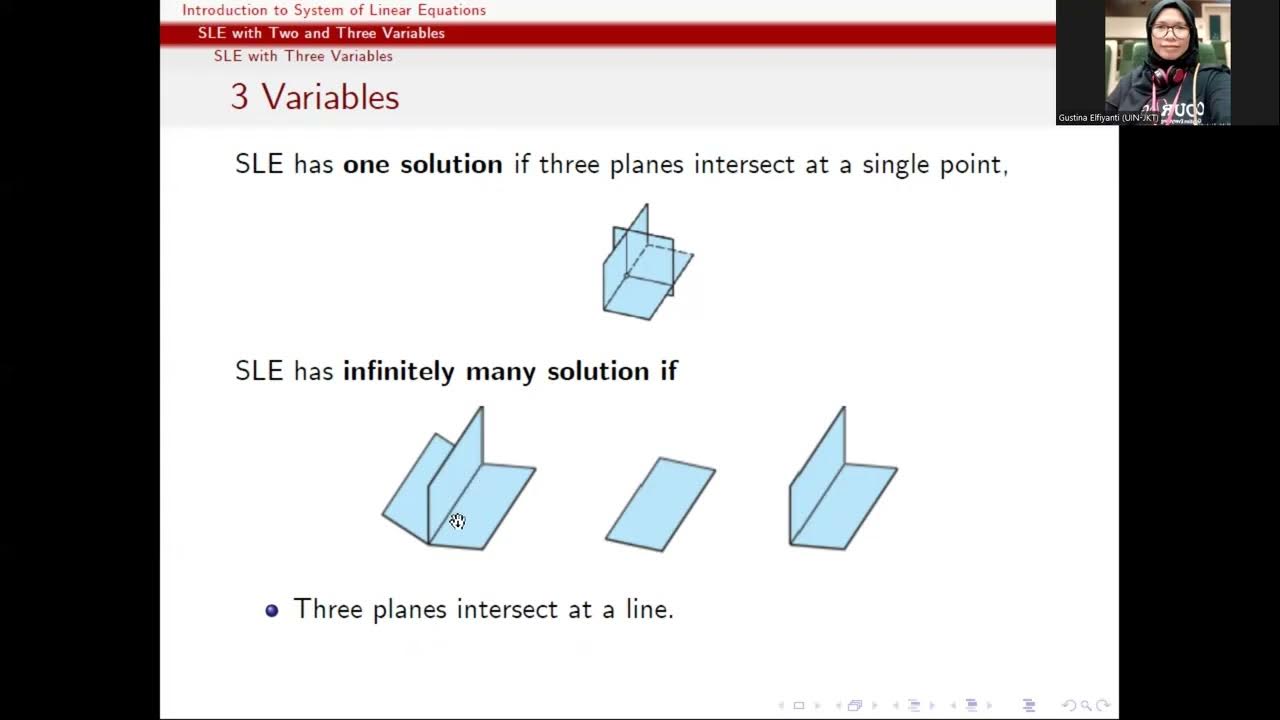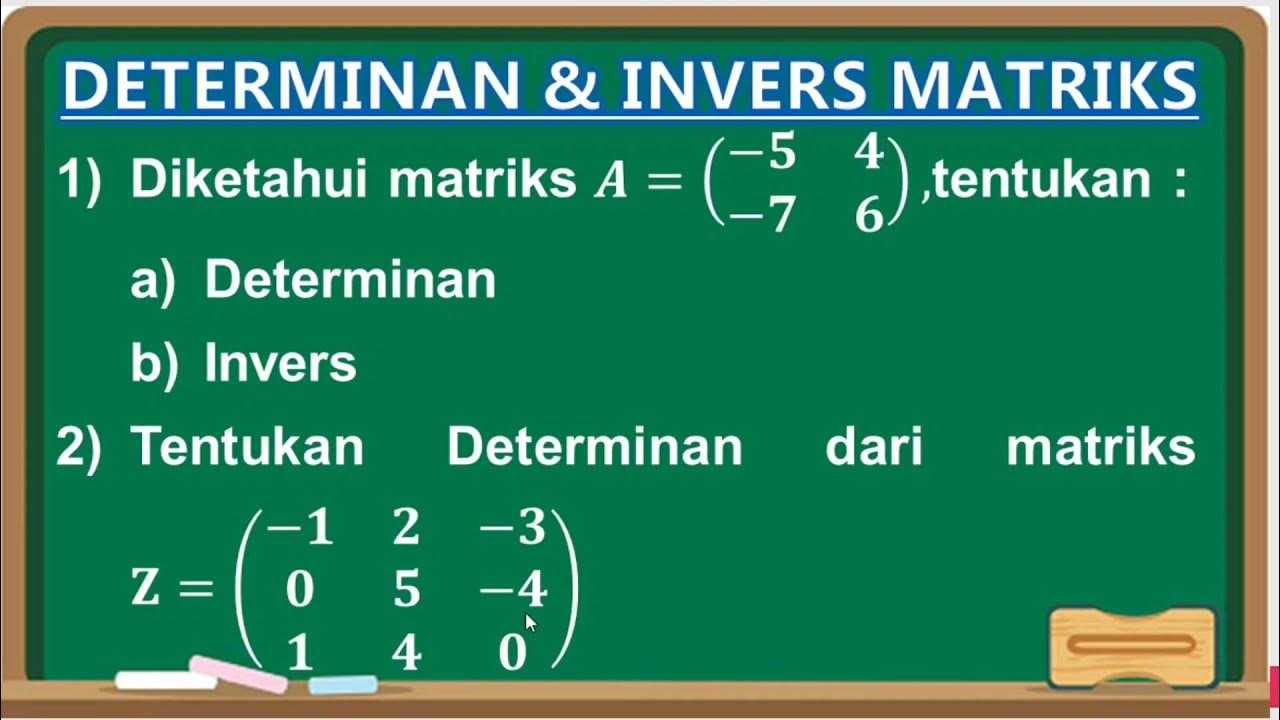MATRIKS RUANG VEKTOR | MENCARI DETERMINAN DENGAN METODE OBE
Summary
TLDRThis video tutorial covers the process of calculating the determinant of matrices using elementary row operations (OB). It starts with simple examples, including 2x2 and 3x3 matrices, demonstrating how to apply basic formulas and the Sarrus rule. The focus then shifts to more complex methods, where row operations are used to transform a matrix into an upper or lower triangular form, making it easier to calculate the determinant. The tutorial explains key row operations—row swap, row multiplication, and row addition—and highlights the importance of these steps in simplifying matrix calculations. The result is an efficient approach to finding matrix determinants.
Takeaways
- 😀 Determinants of matrices can be found using various methods, one of which is the row operation method (OB) or elementary row operations.
- 😀 To compute the determinant of a matrix, it helps to transform it into an upper or lower triangular matrix, where the determinant is simply the product of the diagonal elements.
- 😀 The determinant of a 2x2 matrix is calculated by subtracting the product of the elements of the second row from the product of the elements of the first row.
- 😀 For 3x3 matrices, the determinant can be calculated using the Sarrus rule, which involves summing and subtracting the products of certain elements of the matrix.
- 😀 When performing elementary row operations, it's important to keep track of how these operations affect the determinant: swapping rows multiplies the determinant by -1, multiplying a row by a constant multiplies the determinant by that constant, and adding one row to another doesn't affect the determinant.
- 😀 The objective of row operations is to simplify the matrix into an upper or lower triangular form to easily calculate the determinant.
- 😀 The three types of elementary row operations are: row swapping, multiplying a row by a constant, and adding a multiple of one row to another.
- 😀 When transforming a matrix into a triangular form, the determinant is computed by multiplying the diagonal elements.
- 😀 The process of performing elementary row operations on a matrix can be used to make it into a triangular matrix, either upper or lower, without needing to find the leading ones or pivot positions.
- 😀 The example provided demonstrates that using elementary row operations can be done with either a bottom-up or top-down approach, and both methods yield the same determinant result.
Q & A
What is the primary focus of this video?
-The video focuses on explaining how to calculate the determinant of a matrix using elementary row operations (OB).
What is the first example used in the video to calculate the determinant?
-The first example is a 2x2 matrix, where the determinant is calculated using the formula det(A) = (1 × 3) - (2 × 0), resulting in a determinant of 3.
How does the video explain the process of calculating the determinant of a 3x3 matrix?
-The video uses the Sarrus rule to calculate the determinant of a 3x3 matrix by multiplying and subtracting elements according to a specific pattern.
What is the key takeaway about triangular matrices in this video?
-The key takeaway is that the determinant of a triangular matrix (either upper or lower) is the product of the elements on its main diagonal.
What are the three types of elementary row operations discussed in the video?
-The three types of elementary row operations are: 1) Row swap, 2) Row scaling (multiplying a row by a non-zero constant), and 3) Row addition (adding a multiple of one row to another).
How does the row swap operation affect the determinant?
-The row swap operation changes the sign of the determinant. Specifically, swapping two rows multiplies the determinant by -1.
What happens to the determinant when a row is multiplied by a non-zero constant?
-When a row is multiplied by a non-zero constant, the determinant is scaled by the same constant.
Why is it important to convert a matrix into a triangular form when calculating its determinant?
-Converting a matrix into a triangular form simplifies the calculation of the determinant because the determinant can then be directly calculated by multiplying the elements on the diagonal.
What strategy is used in the video to transform matrices into triangular form?
-The strategy involves performing row operations to create zeros below the leading diagonal elements, either making the matrix upper or lower triangular.
Can the row operation method be used without determining the leading 1 in each column?
-Yes, the method can still be applied without determining the leading 1, but it may involve more complex operations, such as dealing with fractions. The main goal is to make the matrix triangular, not necessarily to reduce it to row echelon form.
Outlines

This section is available to paid users only. Please upgrade to access this part.
Upgrade NowMindmap

This section is available to paid users only. Please upgrade to access this part.
Upgrade NowKeywords

This section is available to paid users only. Please upgrade to access this part.
Upgrade NowHighlights

This section is available to paid users only. Please upgrade to access this part.
Upgrade NowTranscripts

This section is available to paid users only. Please upgrade to access this part.
Upgrade NowBrowse More Related Video

MATRIKS RUANG VEKTOR | OPERASI BARIS ELEMENTER (OBE), MATRIKS ESELON BARIS TEREDUKSI

Introduction to SLE

Cara Menentukan Determinan dan Invers Matriks

Imagen, kernel (o espacio nulo), rango, nulidad, espacio columna y espacio fila de una matriz.

MATRIKS RUANG VEKTOR | NILAI EIGEN MATRIKS 2x2 DAN 3x3

Determinant of 3x3 Matrices, 2x2 Matrix, Precalculus Video Tutorial
5.0 / 5 (0 votes)